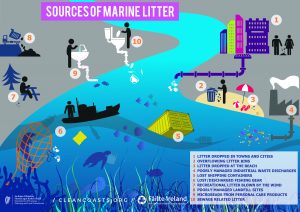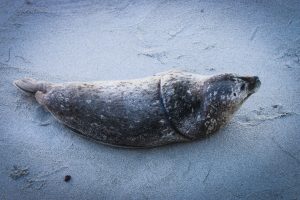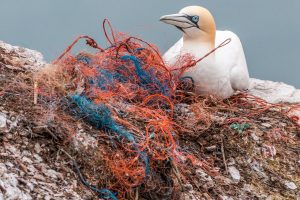Next time you head for the beach and decide to go for a dip, consider this alarming fact: approximately 10 million tonnes of litter end up in the world’s oceans and seas each year. That is equivalent to a full bin truck emptying its load into the sea every minute. It is made up of the stuff you see lying around on the beach like plastic bags and bottles and the rubbish dropped by visitors, but also micro-plastics from our cosmetics, sewerage, waste being washed out by river from our towns and countryside, as well as the nets and other waste from the fishing industry.
Plastics make up 80% of the waste in our waters and by 2050, it is predicted there will be more plastic by weight in the ocean than there are fish.

Plastic in the Ocean
Plastic waste on the beach and in the ocean is extremely damaging to marine life as animals become tangled in the plastic or ingest pieces of plastic that they have mistaken for food. These animals often starve when they fill up on plastics that they cannot digest. It can also have a devastating effect on coral reefs, the sharp plastic pieces cutting the coral and then settling on the reef and blocking out light and oxygen.
 One of the main problems with plastic waste is that it never fully decomposes in the ocean; it only breaks down into minuscule pieces called micro-plastics. These micro-plastics make their way into the marine food chain and eventually onto our plates. A recent report by Plymouth University in the UK found plastic in 33 percent of UK-caught fish.
One of the main problems with plastic waste is that it never fully decomposes in the ocean; it only breaks down into minuscule pieces called micro-plastics. These micro-plastics make their way into the marine food chain and eventually onto our plates. A recent report by Plymouth University in the UK found plastic in 33 percent of UK-caught fish.
Plastic contamination is especially concerning in shellfish such as oysters, clams, and mussels. These animals feed by filtering small particles out of the water, so micro-plastics settle in their digestive systems. Researchers in Portland State University in the US found small amounts of plastic in Pacific Oysters, about 11 pieces per animal. This poses a danger to human health because we eat those oysters whole so that plastic is ending up in our digestive system. While scientists say these shellfish are safe to eat now, that could change as plastic debris in the ocean continues to increase.
So What Can We Do To Help?
Reading those statistics can make pretty depressing reading. While the problem of plastic in the ocean is very serious there are ways that we can all help to find a solution.
This month is Plastic Free July and everyone can take up the challenge to make one small (or big!) step to change their habits and reduce plastic waste. On Plastic Free July’s site they make lots of suggestions for how you can make a difference and how you can educate yourself about the hidden plastics in the food and goods you use.
 So next time you head to the shore take a moment to carry your waste off the beach and bin or recycle it away from the water. Or, even better, try to make efforts to reduce your waste altogether: reusable bags; tupperware containers rather than plastic and cling film; proper knives and forks rather than disposal ones; and reusable water bottles will make your lunch no less delicious but much more sustainable in the long run.
So next time you head to the shore take a moment to carry your waste off the beach and bin or recycle it away from the water. Or, even better, try to make efforts to reduce your waste altogether: reusable bags; tupperware containers rather than plastic and cling film; proper knives and forks rather than disposal ones; and reusable water bottles will make your lunch no less delicious but much more sustainable in the long run.
You might also consider joining in with one of the Clean Coast Beach Cleans happening all around the country every week, full details are on their Facebook Page. Another great initiative is BIM’s Fishing For Litter scheme, which encourages fishermen to collect the rubbish they find in the sea and bring it back to shore. You can sign up today on their website. There are 12 ports around the country collecting the bags from fishing vessels and they say that since the scheme started in 2015 they have already collected 220 tonnes of marine litter.
And the good news is it’s not too late – if we act together now to make a change we can protect the world’s coastlines, oceans and marine ecosystems for future generations.
